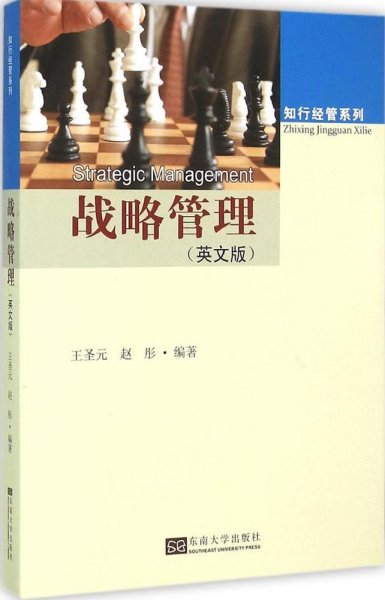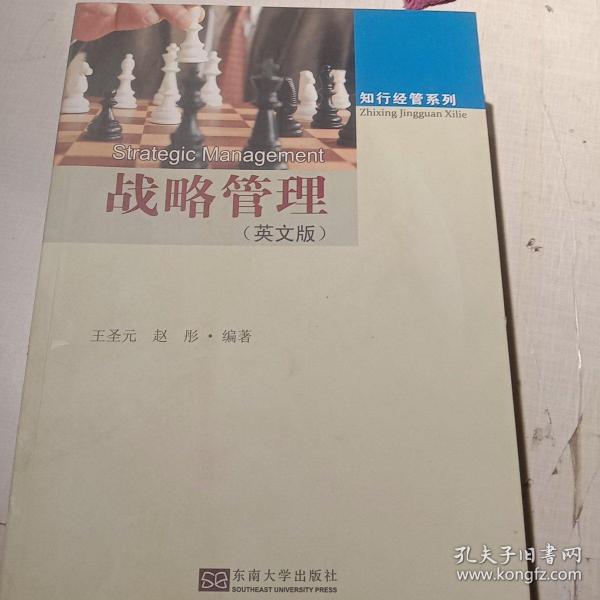知行经管系列:战略管理(英文版)
出版时间:
2015-12
版次:
1
ISBN:
9787564161927
定价:
49.80
装帧:
平装
开本:
16开
纸张:
胶版纸
页数:
432页
字数:
727千字
正文语种:
英语
-
《知行经管系列:战略管理(英文版)》在借鉴和吸收国内外战略管理理论和新研究成果的基础上,密切结合国内企业战略管理的实际情况,介绍了战略管理的基础知识、基本方法和战略管理的前沿问题。战略管理的内容从三大阶段,即战略设计、战略实施和战略评估展开,详述了战略管理包含的四个关键要素:战略分析——了解组织所处的环境和相对竞争地位;战略选择——战略制定、评价和选择;战略实施——采取措施发挥战略作用;战略评价和调整——检验战略的有效性。《知行经管系列:战略管理(英文版)》在内容方面的特色在于既包括基础理论和前沿性内容,又包括实务方面的知识,深入浅出,体系新颖完善。 Part 1 Fundamentals of Strategy
Chapter 1Strategic Management
1.1 Concept
1.2 The Competitive I.andscape
1.3 The I/O Model of Above—Average Returns
1.4 The Resource—Based Model of Above—Average Returns
1.5 Vision and Mission
1.6 Stakeholders
Chapter 2 The External Environment Analysis
2.1 The General,Industry,and Competitor Environments
2.2 External Environmental Analysis
2.3 Segments of the General Environment
2.4 Industry Environment Analysis
2.5 Interpreting Industry Analyses
2.6 Strategic Groups
Chapter 3 The Internal Organization
3.1 Analyzing the Internal Organization
3.2 Resources,Capabilities,and Core Competencies
3.3 Core Competencies
3.4 Outsourcing
3.5 Strategic Decisions
Chapter 4 Business Level Strategy
4.1 Business—Level Strategy
4.2 Customers:Their Relationship with BusinessLevel Strategies
4.3 The Purpose of a Business—Level Strategy
4.4 Types of Business—Level Strategies
Chapter 5 Competitive Behavior
5.1 A Model of Competitive Rivalry
5.2 Competitor Analysis
5.3 Drivers of Competitive Actions
5.4 Competitive Rivalry
5.5 Likelihood of Attack
5.6 Likelihood of Response
5.7 Competitive Dynamics
Chapter 6 CorporateLevel Strategy
6.1 Levels of Diversification
6.2 Reasons for Diversification
6.3 Value—Creating Diversification
6.4 Diversification
6.5 Unrelated Diversification
6.6 Value—Neutral Diversification
6.7 ValueReducing Diversification:Managerial Motives to Diversify
Chapter 7 Merger and Acquisition Strategies
7.1 The Popularity of Merger and Acquisition Strategies
7.2 Reasons for Acquisitions
7.3 Problems in Achieving Acquisition Success
7.4 Effective Acquisitions
7.5 Restructuring
Chapter 8 International Strategy
8.1 Identifying International Opportunities:Incentives to Use an International Strategy
8.2 International Strategies
8.3 Environmental Trends
8.4 International Entry Mode
8.5 Strategic Competitive Outcomes
8.6 Risks in an International Environment
Chapter 9 Cooperative Strategy
9.1 Strategic Alliances as a Primary Type of Cooperative Strategy
9.2 Business—Level Cooperative Strategy
9.3 Corporate—I.evel Cooperative Strategy
9.4 International Cooperative Strategy
9.5 Network Cooperative Strategy _
9.6 Competitive Risks with Cooperative Strategies
9.7 Managing Cooperative Strategies
Chapter 10 Corporate Governance_
10.1 Separation of Ownership and Managerial Control
10.2 Ownership Concentration
10.3 Board of Directors
10.4 Executive Compensation
10.5 Market for Corporate Control
10.6 International Corporate Governance
10.7 Governance Mechanisms and Ethical Behavior
Chapter 11 organizatiOnal Structure and Control
11.1 Organizational Structure and Controls
11.2 Relationships between Strategy and Structure
11.3 Evolutionary Patterns of Strategy and Organizational Structure
11.4 Implementing Business—Level Cooperative Strategies
11.5 Implementing Corporate—Level Cooperative Strategies
11.6 Implementing International Cooperative Strategies
Chapter 12 Strategic Leadership
12.1 Strategic Leadership and Style
12.2 The Role of Top—Level Managers
12.3 Managerial Succession
12.4 Key Strategic Leadership Actions
Part 2 Special Topics of Strategy
Chapter 13 Strategic Information System
13.1 History of SIS
13.2 Definition
13.3 Three General Types
13.4 Gaining Competitive Advantage
13.5 Models for Strategic Information System
Chapter 14 Strategic Alliance
14.1 Definitions
14.2 Typology
14.3 Historical Development of Strategic Alliances
14.4 Goals of Strategic Alliances
14.5 AdVantages/Disadvantages
14.6 Success Factors
14.7 Further Important Factors
14.8 Risks
14.9 Importance of Strategic Alliances
14.10 Life Cycle of a Strategic Alliance
Chapter 15 Strategic Innovation
15.1 Define Strategic Entrepreneurship and Corporate Entrepreneurship
15.2 Entrepreneurship and Entrepreneurial Opportunities
15.3 Innovation
15.4 International Entrepreneurship
15.5 Incremental and Radical Innovation
15.6 Implementing Internal Innovations
15.7 Innovation through Cooperative Strategies
15.8 Innovation through Acquisitions
15.9 Creating Value through Strategic Entrepreneurship
Chapter 16 Strategy and Game Theory
16.1 Strategy
16.2 Nash Equilibrium
16.3 Evolutionarily Stable Strategy
Chapter 17 Industry 4.0 and Strategy
17.1 Industry 4.0
l7.2 Comparison of Germany and China,the Industry 4.0 Strategy Approach for China
Chapter 18 Electronic Business and Strategy_
18.1 Electronic Business
18.2 Concerns
18.3 Online Shopping
18.4 Customers
18.5 Payment
18.6 Product Delivery
18.7 Shopping Cart systems
18.8 Advantages
18.9 Disadvantages
18.10 Impact of Reviews on Consumer Behaviour
Part 3 Research Methods and Exercises
Chapter 19 Qualitative Research
19.1 Data Collection,Analysis and Field Research Design
19.2 Specialized Uses of Qualitative Research
19.3 Data Analysis
Chapter 20 Quantitative Research
20.1 CIverview
20.2 Use of Statistics
20.3 Measurement
20.4 Relationship with Qualitative Methods
Chapter 21 Survey Research
21.1 Sampling
21.2 Correlation and Causality
21.3 Research Designs
21.4 Questionnaires
Chapter 22 Sampling
22.1 Population Definition
22.2 Sampling Frame
22.3 Probability and Nonprobability Sampling
22.4 Sampling Methods
22.5 Errors in Sample Surveys
22.6 Survey Weights
Chapter 23 Secondary Research
23.1 Secondary Research
23.2 Meta—Analysis
Chapter 24 Strategic Management Cases
24.1 It Was the Season for E—Splurging
24.2 Business Japanese—Style
24.3 Public Policy and Ethics in Marketing Research
24.4 From Stiff Upper Lip to New British Hip—British Airways Updates Its Image and Its Fleet
24.5 The Meat and Potatoes of Online Shopping
24.6 Foreign Rivals VS.the Chinese:If You Can’t Beat Them
24.7 The Buyer Always Wins
24.8 The Rise and Fall of New Coke:What’S the Problem7
24.9 Value Pricing:Offering More for Less
24.10 International Promotional Strategy
24.11 International Segmentation
24.12 FedExCreating Competitive Advantage
24.13 From A—Z,Not A—B:DHL Is Far More Than Just a Carrier
24.14 Practice Cases Magna Health
Chapter 25 Experiential Exercises
25.1 Creating a Shared Vision
25.2 The Oracle at Delphi
25.3 Internet Exercise
25.4 Customer Needs and Stock Trading
25.5 Internet Exercise:Cisco Systems
25.6 Corporate Juggling
25.7 Governance and Personal Investments
参考文献(References)
后记
-
内容简介:
《知行经管系列:战略管理(英文版)》在借鉴和吸收国内外战略管理理论和新研究成果的基础上,密切结合国内企业战略管理的实际情况,介绍了战略管理的基础知识、基本方法和战略管理的前沿问题。战略管理的内容从三大阶段,即战略设计、战略实施和战略评估展开,详述了战略管理包含的四个关键要素:战略分析——了解组织所处的环境和相对竞争地位;战略选择——战略制定、评价和选择;战略实施——采取措施发挥战略作用;战略评价和调整——检验战略的有效性。《知行经管系列:战略管理(英文版)》在内容方面的特色在于既包括基础理论和前沿性内容,又包括实务方面的知识,深入浅出,体系新颖完善。
-
目录:
Part 1 Fundamentals of Strategy
Chapter 1Strategic Management
1.1 Concept
1.2 The Competitive I.andscape
1.3 The I/O Model of Above—Average Returns
1.4 The Resource—Based Model of Above—Average Returns
1.5 Vision and Mission
1.6 Stakeholders
Chapter 2 The External Environment Analysis
2.1 The General,Industry,and Competitor Environments
2.2 External Environmental Analysis
2.3 Segments of the General Environment
2.4 Industry Environment Analysis
2.5 Interpreting Industry Analyses
2.6 Strategic Groups
Chapter 3 The Internal Organization
3.1 Analyzing the Internal Organization
3.2 Resources,Capabilities,and Core Competencies
3.3 Core Competencies
3.4 Outsourcing
3.5 Strategic Decisions
Chapter 4 Business Level Strategy
4.1 Business—Level Strategy
4.2 Customers:Their Relationship with BusinessLevel Strategies
4.3 The Purpose of a Business—Level Strategy
4.4 Types of Business—Level Strategies
Chapter 5 Competitive Behavior
5.1 A Model of Competitive Rivalry
5.2 Competitor Analysis
5.3 Drivers of Competitive Actions
5.4 Competitive Rivalry
5.5 Likelihood of Attack
5.6 Likelihood of Response
5.7 Competitive Dynamics
Chapter 6 CorporateLevel Strategy
6.1 Levels of Diversification
6.2 Reasons for Diversification
6.3 Value—Creating Diversification
6.4 Diversification
6.5 Unrelated Diversification
6.6 Value—Neutral Diversification
6.7 ValueReducing Diversification:Managerial Motives to Diversify
Chapter 7 Merger and Acquisition Strategies
7.1 The Popularity of Merger and Acquisition Strategies
7.2 Reasons for Acquisitions
7.3 Problems in Achieving Acquisition Success
7.4 Effective Acquisitions
7.5 Restructuring
Chapter 8 International Strategy
8.1 Identifying International Opportunities:Incentives to Use an International Strategy
8.2 International Strategies
8.3 Environmental Trends
8.4 International Entry Mode
8.5 Strategic Competitive Outcomes
8.6 Risks in an International Environment
Chapter 9 Cooperative Strategy
9.1 Strategic Alliances as a Primary Type of Cooperative Strategy
9.2 Business—Level Cooperative Strategy
9.3 Corporate—I.evel Cooperative Strategy
9.4 International Cooperative Strategy
9.5 Network Cooperative Strategy _
9.6 Competitive Risks with Cooperative Strategies
9.7 Managing Cooperative Strategies
Chapter 10 Corporate Governance_
10.1 Separation of Ownership and Managerial Control
10.2 Ownership Concentration
10.3 Board of Directors
10.4 Executive Compensation
10.5 Market for Corporate Control
10.6 International Corporate Governance
10.7 Governance Mechanisms and Ethical Behavior
Chapter 11 organizatiOnal Structure and Control
11.1 Organizational Structure and Controls
11.2 Relationships between Strategy and Structure
11.3 Evolutionary Patterns of Strategy and Organizational Structure
11.4 Implementing Business—Level Cooperative Strategies
11.5 Implementing Corporate—Level Cooperative Strategies
11.6 Implementing International Cooperative Strategies
Chapter 12 Strategic Leadership
12.1 Strategic Leadership and Style
12.2 The Role of Top—Level Managers
12.3 Managerial Succession
12.4 Key Strategic Leadership Actions
Part 2 Special Topics of Strategy
Chapter 13 Strategic Information System
13.1 History of SIS
13.2 Definition
13.3 Three General Types
13.4 Gaining Competitive Advantage
13.5 Models for Strategic Information System
Chapter 14 Strategic Alliance
14.1 Definitions
14.2 Typology
14.3 Historical Development of Strategic Alliances
14.4 Goals of Strategic Alliances
14.5 AdVantages/Disadvantages
14.6 Success Factors
14.7 Further Important Factors
14.8 Risks
14.9 Importance of Strategic Alliances
14.10 Life Cycle of a Strategic Alliance
Chapter 15 Strategic Innovation
15.1 Define Strategic Entrepreneurship and Corporate Entrepreneurship
15.2 Entrepreneurship and Entrepreneurial Opportunities
15.3 Innovation
15.4 International Entrepreneurship
15.5 Incremental and Radical Innovation
15.6 Implementing Internal Innovations
15.7 Innovation through Cooperative Strategies
15.8 Innovation through Acquisitions
15.9 Creating Value through Strategic Entrepreneurship
Chapter 16 Strategy and Game Theory
16.1 Strategy
16.2 Nash Equilibrium
16.3 Evolutionarily Stable Strategy
Chapter 17 Industry 4.0 and Strategy
17.1 Industry 4.0
l7.2 Comparison of Germany and China,the Industry 4.0 Strategy Approach for China
Chapter 18 Electronic Business and Strategy_
18.1 Electronic Business
18.2 Concerns
18.3 Online Shopping
18.4 Customers
18.5 Payment
18.6 Product Delivery
18.7 Shopping Cart systems
18.8 Advantages
18.9 Disadvantages
18.10 Impact of Reviews on Consumer Behaviour
Part 3 Research Methods and Exercises
Chapter 19 Qualitative Research
19.1 Data Collection,Analysis and Field Research Design
19.2 Specialized Uses of Qualitative Research
19.3 Data Analysis
Chapter 20 Quantitative Research
20.1 CIverview
20.2 Use of Statistics
20.3 Measurement
20.4 Relationship with Qualitative Methods
Chapter 21 Survey Research
21.1 Sampling
21.2 Correlation and Causality
21.3 Research Designs
21.4 Questionnaires
Chapter 22 Sampling
22.1 Population Definition
22.2 Sampling Frame
22.3 Probability and Nonprobability Sampling
22.4 Sampling Methods
22.5 Errors in Sample Surveys
22.6 Survey Weights
Chapter 23 Secondary Research
23.1 Secondary Research
23.2 Meta—Analysis
Chapter 24 Strategic Management Cases
24.1 It Was the Season for E—Splurging
24.2 Business Japanese—Style
24.3 Public Policy and Ethics in Marketing Research
24.4 From Stiff Upper Lip to New British Hip—British Airways Updates Its Image and Its Fleet
24.5 The Meat and Potatoes of Online Shopping
24.6 Foreign Rivals VS.the Chinese:If You Can’t Beat Them
24.7 The Buyer Always Wins
24.8 The Rise and Fall of New Coke:What’S the Problem7
24.9 Value Pricing:Offering More for Less
24.10 International Promotional Strategy
24.11 International Segmentation
24.12 FedExCreating Competitive Advantage
24.13 From A—Z,Not A—B:DHL Is Far More Than Just a Carrier
24.14 Practice Cases Magna Health
Chapter 25 Experiential Exercises
25.1 Creating a Shared Vision
25.2 The Oracle at Delphi
25.3 Internet Exercise
25.4 Customer Needs and Stock Trading
25.5 Internet Exercise:Cisco Systems
25.6 Corporate Juggling
25.7 Governance and Personal Investments
参考文献(References)
后记
查看详情
-
战略管理
正版新书 新华官方库房直发 可开电子发票
全新
江苏省南京市
平均发货7小时
成功完成率98.13%
-
全新
山东省泰安市
平均发货22小时
成功完成率86.27%
-
全新
-
全新
广东省广州市
平均发货19小时
成功完成率86.61%
-
全新
上海市黄浦区
平均发货11小时
成功完成率94.31%
-
全新
山东省泰安市
平均发货8小时
成功完成率93.4%
-
全新
天津市河北区
平均发货23小时
成功完成率74.15%
-
全新
山东省泰安市
平均发货24小时
成功完成率92.53%
-
战略管理(英文版)
书籍均为精品二手图书品相85品以上,出库会经过高温消毒,书籍上架都会检测可保证正版!!
九品
天津市宝坻区
平均发货15小时
成功完成率95.31%
-
战略管理
正版新书 新华官方库房直发 可开电子发票
全新
江苏省南京市
平均发货8小时
成功完成率96.28%
-
八五品
江苏省南京市
平均发货19小时
成功完成率81.76%
-
全新
北京市西城区
平均发货24小时
成功完成率90.78%
-
全新
天津市西青区
平均发货14小时
成功完成率90.09%
-
全新
北京市丰台区
平均发货8小时
成功完成率90.84%
-
全新
北京市海淀区
平均发货11小时
成功完成率93.29%
-
全新
四川省成都市
平均发货17小时
成功完成率81.27%
-
全新
北京市通州区
平均发货11小时
成功完成率93.95%
-
战略管理
正版新书 新华官方库房直发 可开电子发票
全新
江苏省南京市
平均发货15小时
成功完成率82.5%
-
战略管理:英文版
重要提醒:::重要提醒::所有图书保证正版,按书名发货图片仅供参考, 有疑问请咨询客服,看清书名按书名发货
全新
北京市通州区
平均发货9小时
成功完成率89.61%
-
八五品
四川省成都市
平均发货12小时
成功完成率91.64%
-
全新
天津市河东区
平均发货27小时
成功完成率90.97%
-
全新
北京市朝阳区
平均发货9小时
成功完成率96.79%
-
九品
安徽省阜阳市
平均发货55小时
成功完成率80.28%
-
九品
江苏省南京市
平均发货16小时
成功完成率91.58%
-
九五品
上海市徐汇区
平均发货14小时
成功完成率87.6%
-
九品
上海市长宁区
平均发货19小时
成功完成率75.83%
-
全新
北京市朝阳区
平均发货14小时
成功完成率93.47%
-
全新
广东省广州市
平均发货7小时
成功完成率88.44%
-
全新
广东省广州市
平均发货16小时
成功完成率96.12%
-
全新
广东省广州市
平均发货10小时
成功完成率86.95%
-
全新
山东省泰安市
平均发货13小时
成功完成率91.63%
-
全新
北京市丰台区
平均发货24小时
成功完成率88.14%
-
九品
北京市海淀区
平均发货24小时
成功完成率87.27%
-
全新
江苏省苏州市
平均发货9小时
成功完成率95.64%
-
全新
北京市海淀区
平均发货13小时
成功完成率91.29%
-
全新
四川省成都市
平均发货57小时
成功完成率83.17%

 占位居中
占位居中










































































